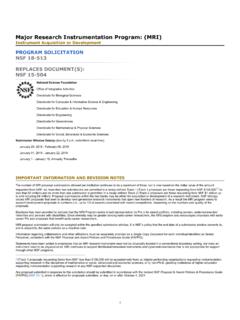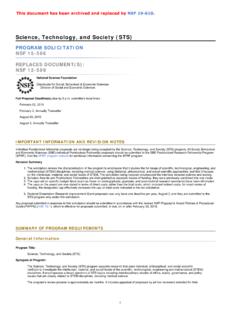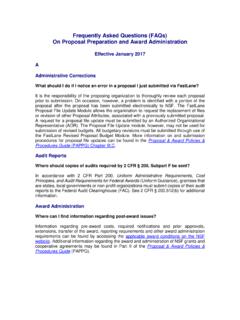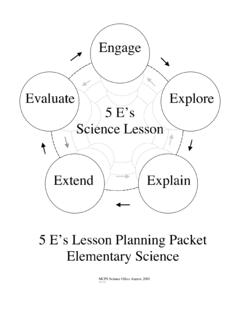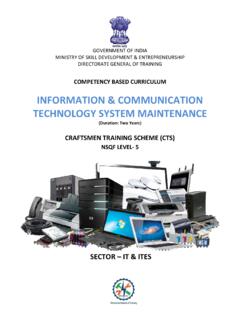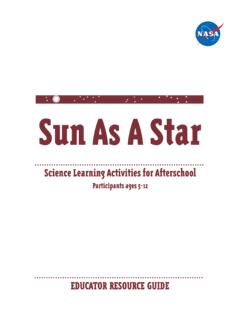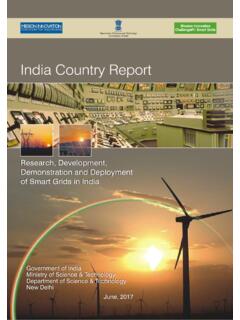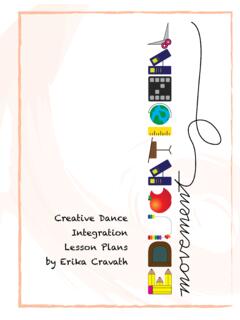Transcription of Sample Dissemination Plan - NSF - National Science …
1 Abstract The goal of the project is The project is developing computer-based instructional modules for statics and mechanics of materials. The project uses 3D rendering and animation software, in which the user manipulates virtual 3D objects in much the same manner as they would physical objects. Tools being developed enable instructors to realistically include external forces and internal reactions on 3D objects as topics are being explained during lectures. Exercises are being developed for students to be able to communicate with peers and instructors through real-time voice and text interactions. The material is being beta tested at multiple institutions including community colleges. The project is being evaluated by The project is being disseminated through . 1. Sample Dissemination plan This project will serve as a pilot for other courses at the University of ____ and at other colleges and universities throughout the country.
2 The results of our evaluation will be disseminated on the University's web site, which will contain a special page devoted to this NSF-sponsored project. Additional Dissemination will occur through presentations at conferences, such as teacher education and Science education conferences, regionally and nationally, and through articles published in peer-reviewed journals. Sample Evaluation plan Assessment of the Student Response Technology (SRT). will be both quantitative and qualitative. First, students will be surveyed at the end of the semester on the content, level of difficulty, and their perceived level of mastery of the concepts of Statics. Second, faculty members teaching the course using SRT will be asked to judge its effectiveness in monitoring student achievement throughout the semester. In addition, faculty members who have been teaching Statics courses for several years will be asked to compare students'.
3 Abilities after using SRT with those in previous years who have not used SRT. Finally, the final grades of students using SRT will be compared with those from previous years who have not used the technology in the classroom. 1. Excerpts from the Project Description The project will involve the collaboration of six institutions, two of which are community colleges. The PIs will work with an advisory board made up of materials engineers from different industry sectors. The industry board will contribute ideas for examples, demonstrations, design problems, and laboratory projects. A community college partnership with the lead university and community colleges in the area will be used to solicit input on the modules from the community colleges.. The modular format of the curriculum will allow the material to be easily adapted to other institutions and even other courses.
4 Curriculum will be developed at one institution and beta tested at another institution. The testing allows verification of the utility and adaptability of the curriculum to multiple universities. The institutions involved in the development and beta testing represent a diverse set of engineering schools, including primarily teaching universities, research universities, and community colleges. They also represent diverse student populations and different campus cultures. For example, the lead university has very large minority and transfer student populations. One of the collaborating institutions has a large population of non-traditional freshman (average age 5-6 years older than the traditional freshmen).. Each of the two sets of modules will involve demonstrations that show how materials Science and engineering relates to modern technologies.
5 These demonstrations would be ideal for use in recruiting at the high school level. The goal of all of these outreach activities is to excite students about engineering and increase the number and diversity of students entering the field. The modules developed for the Introduction to Materials class have the potential to address this problem. For each module, the PIs will develop a small packet that includes handouts on the relevant materials Science and engineering concepts and instructions for a classroom demonstration . These will be distributed to local high schools with a letter encouraging teachers to distribute them to interested students.. Surveys of freshmen and sophomores who left engineering found that the most important reason cited for women and second most important for men was that the reason for choosing the major was found inappropriate.
6 In other words, a significant number of students were not retained because they no longer felt engineering offered interesting work or many job opportunities. Thus, retention of engineering students may be improved by placing the freshman and sophomore curriculum more in the context of true engineering where they can see these opportunities. Efforts across the nation to enhance the experience in freshmen engineering courses by adding design and/or project-based components are a reflection of this effort.. Relevant conferences and journals where this work will be presented include American Society for Engineering Education Annual Conference, ASEE/IEEE Frontiers in Education Annual Conference, Materials Research Society Education Symposium, Journal of Engineering Education, and the Journal of Materials Education.
7 The full content of the modules will be placed on CD-ROM. A major engineering publisher will publish the modules.. A. REVIEW CRITERIA. All NSF proposals are evaluated through use of two National Science Board approved merit review criteria. In some instances, however, NSF will employ additional criteria as required to highlight the specific objectives of certain programs and activities. For example, proposals for large facility projects also might be subject to special review criteria outlined in the program solicitation. The two merit review criteria are listed below. The criteria include considerations that help define them. These considerations are suggestions, and not all will apply to any given proposal. While proposers must address both merit review criteria, reviewers will be asked to address only those considerations that are relevant to the proposal being considered and for which the reviewer is qualified to make judgments.
8 What is the intellectual merit of the proposed activity? How important is the proposed activity to advancing knowledge and understanding within its own field or across different fields? How well qualified is the proposer (individual or team) to conduct the project? (If appropriate, the reviewer will comment on the quality of prior work.) To what extent does the proposed activity suggest and explore creative and original concepts? How well conceived and organized is the proposed activity? Is there sufficient access to resources? What are the broader impacts of the proposed activity? 33. How well does the activity advance discovery and understanding while promoting teaching, training, and learning? How well does the proposed activity broaden the participation of underrepresented groups ( , gender, ethnicity, disability, geographic, etc.)
9 ? To what extent will it enhance the infrastructure for research and education, such as facilities, instrumentation, networks, and partnerships? Will the results be disseminated broadly to enhance scientific and technological understanding? What may be the benefits of the proposed activity to society? NSF staff will give careful consideration to the following in making funding decisions: Integration of Research and Education One of the principal strategies in support of NSF's goals is to foster integration of research and education through the programs, projects and activities it supports at academic and research institutions. These institutions provide abundant opportunities where individuals may concurrently assume responsibilities as researchers, educators, and students, and where all can engage in joint efforts that infuse education with the excitement of discovery and enrich research through the diversity of learning perspectives.
10 Integrating Diversity into NSF Programs, Projects, and Activities Broadening opportunities and enabling the participation of all citizens, women and men, underrepresented minorities, and persons with disabilities, are essential to the health and vitality of Science and engineering. NSF is committed to this principle of diversity and deems it central to the programs, projects, and activities it considers and supports. From Grant Proposal Guide NSF 04-23.
